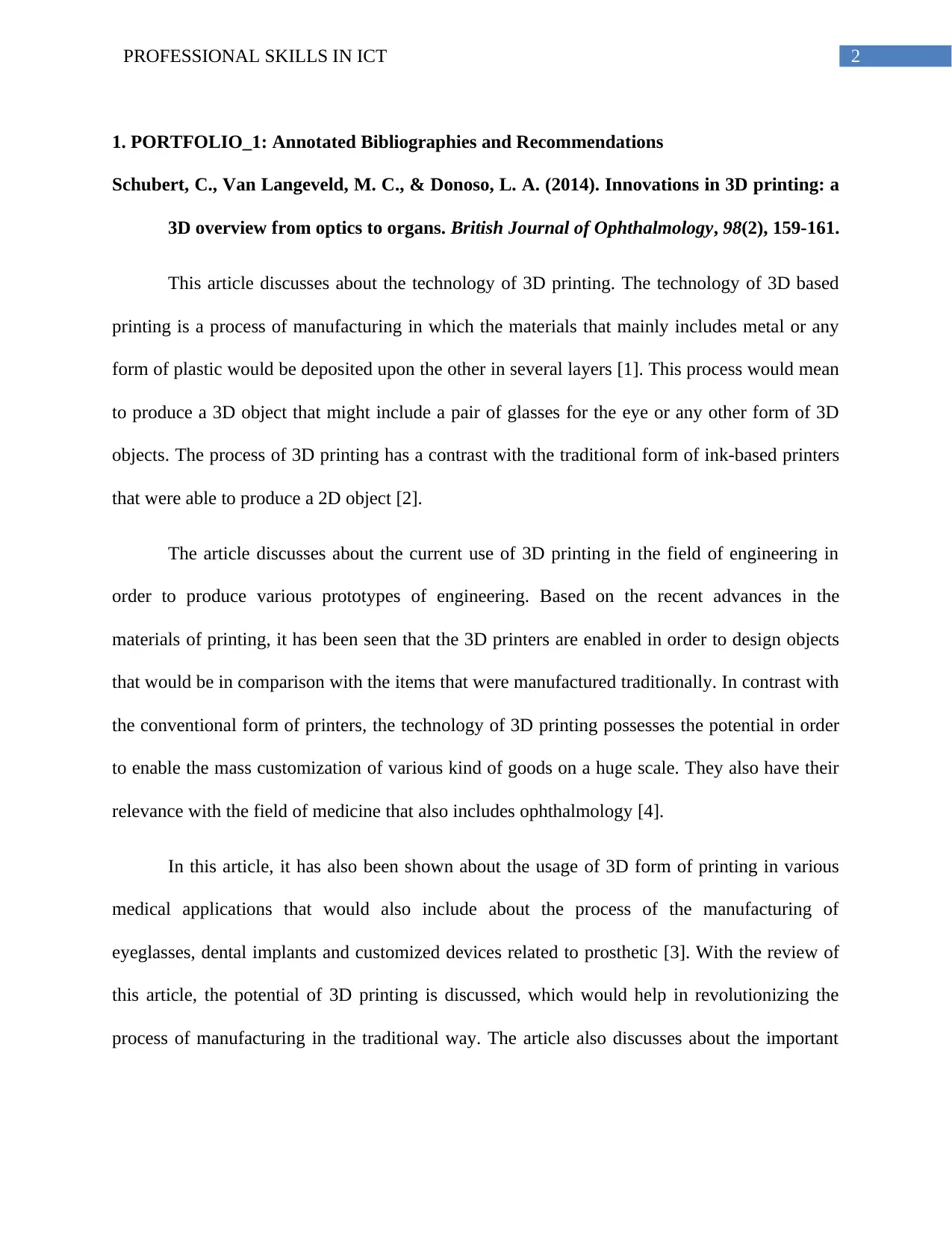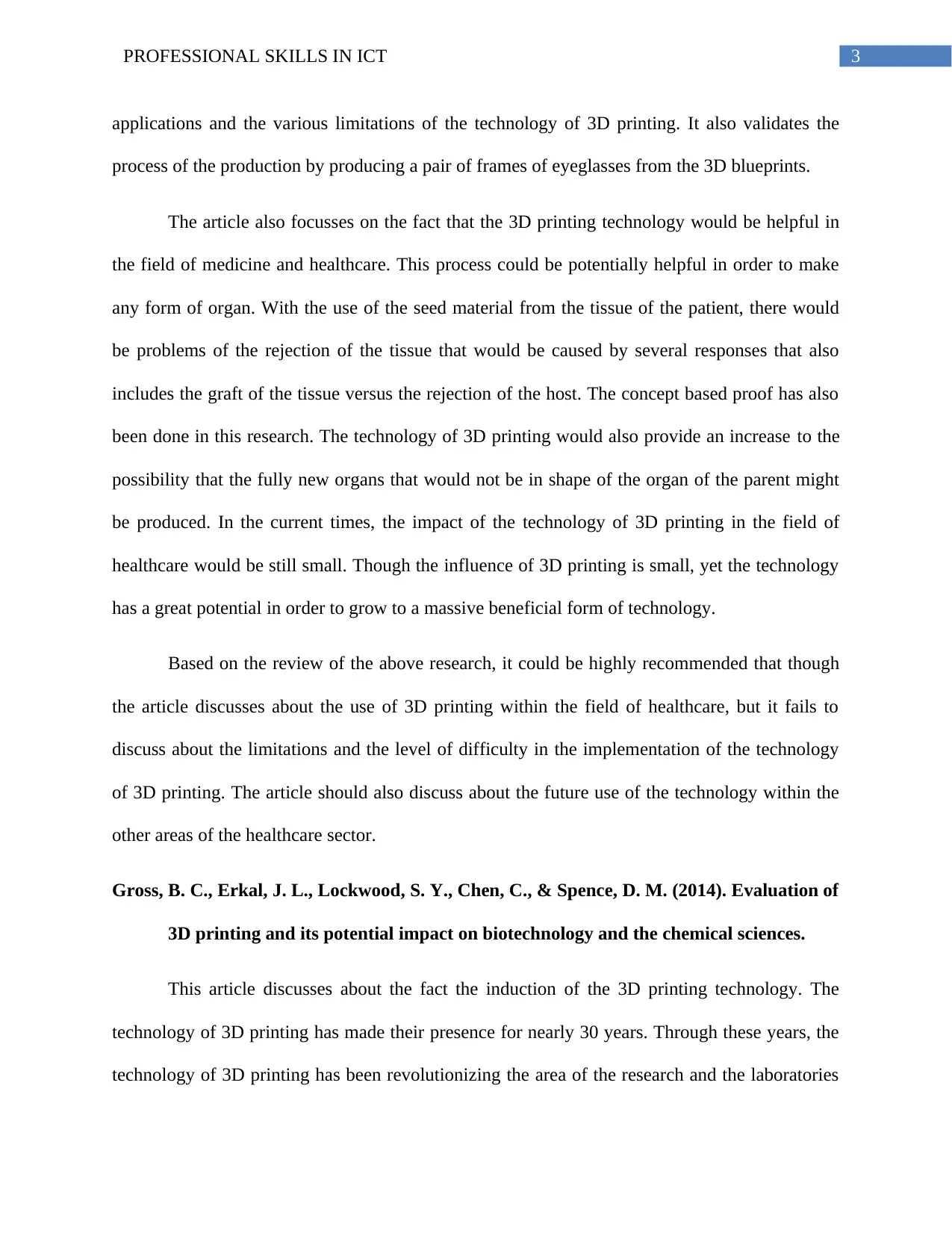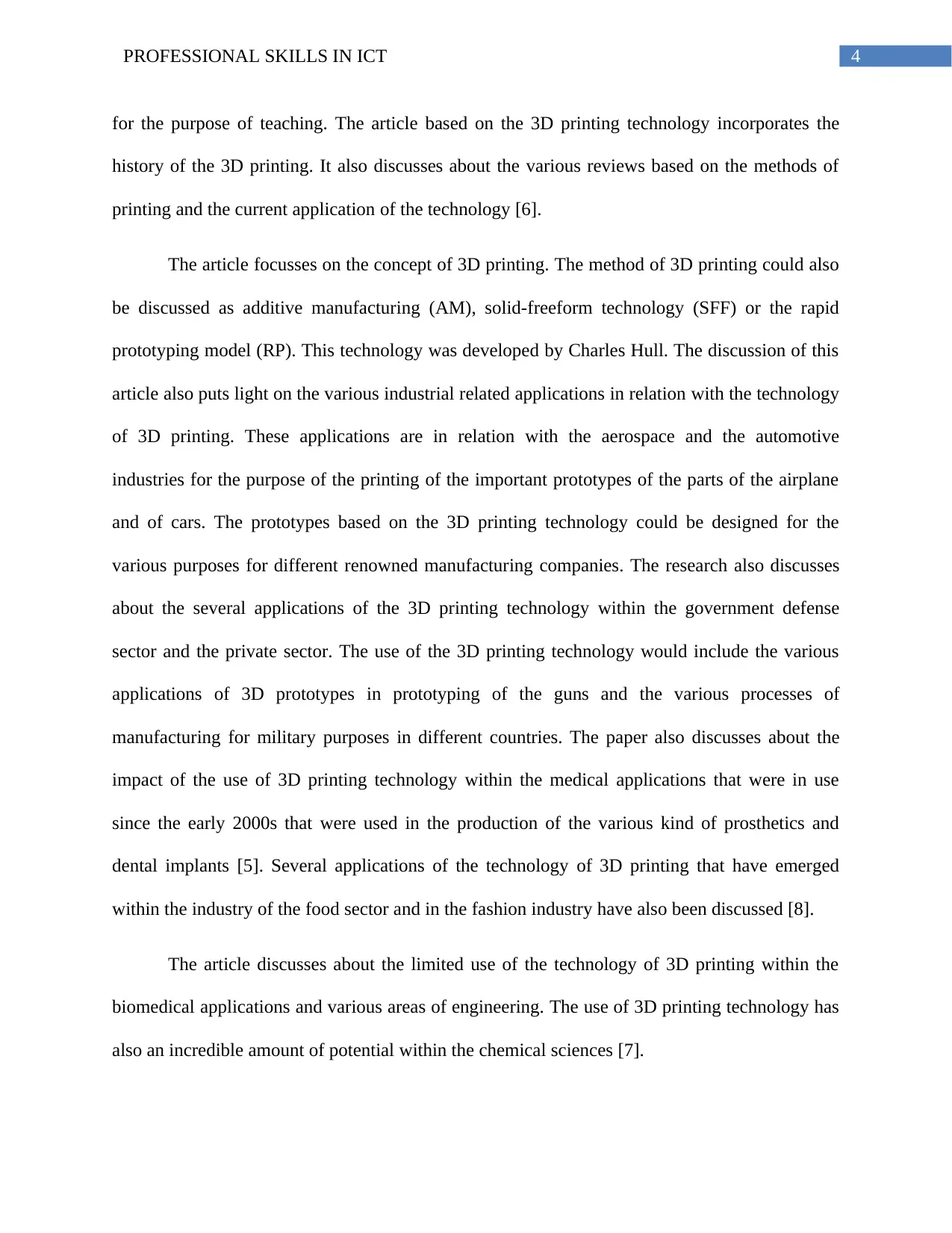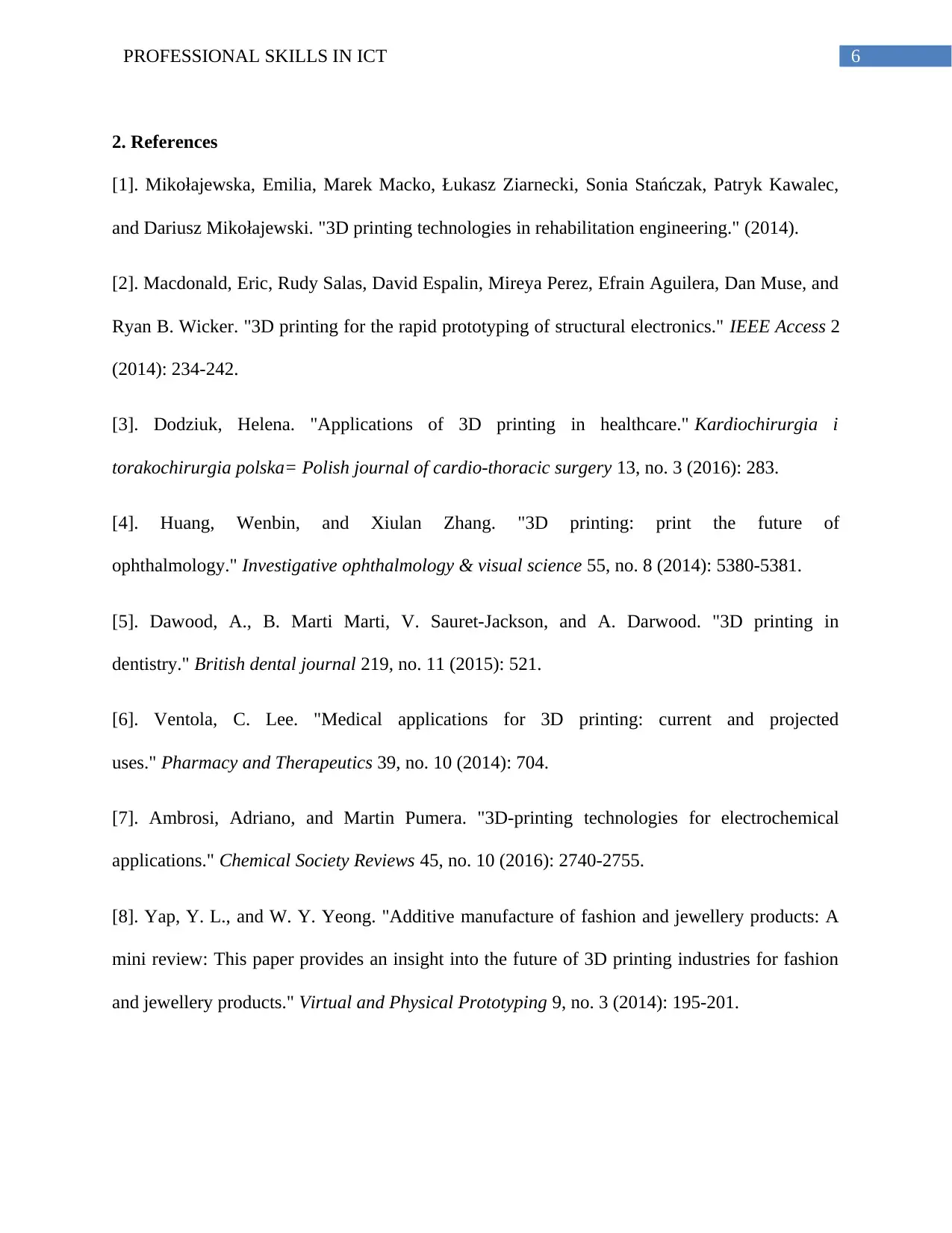Professional Skills in ICT: Annotated Bibliography and Recommendations
VerifiedAdded on 2021/06/18
|7
|1513
|88
Report
AI Summary
This report, focusing on professional skills in ICT, presents an annotated bibliography and recommendations based on several research articles. The core theme revolves around the technology of 3D printing and its applications across various sectors, including engineering, medicine, biotechnology, and chemical sciences. The report examines articles discussing the 3D printing process, its contrast with traditional manufacturing, and its potential for mass customization and rapid prototyping. It highlights the use of 3D printing in producing prototypes, medical devices, and even organs. The analysis also covers the limitations and challenges in implementing 3D printing technology, and the need for further research. Furthermore, the report provides recommendations for improving the use of 3D printing in different fields, emphasizing its potential for revolutionizing manufacturing and healthcare, while also acknowledging the need for further exploration in areas like biotechnology and chemical sciences. The annotated bibliography includes references to articles discussing 3D printing in rehabilitation, structural electronics, healthcare, ophthalmology, dentistry, and other applications, providing a comprehensive overview of the technology's impact and future possibilities.

Running head: PROFESSIONAL SKILLS IN ICT
Professional Skills in ICT
Name of the Student
Name of the University
Authors’ note:
Professional Skills in ICT
Name of the Student
Name of the University
Authors’ note:
Paraphrase This Document
Need a fresh take? Get an instant paraphrase of this document with our AI Paraphraser

1PROFESSIONAL SKILLS IN ICT
Table of Contents
1. PORTFOLIO_1: Annotated Bibliographies and Recommendations..........................................2
2. References....................................................................................................................................5
Table of Contents
1. PORTFOLIO_1: Annotated Bibliographies and Recommendations..........................................2
2. References....................................................................................................................................5

2PROFESSIONAL SKILLS IN ICT
1. PORTFOLIO_1: Annotated Bibliographies and Recommendations
Schubert, C., Van Langeveld, M. C., & Donoso, L. A. (2014). Innovations in 3D printing: a
3D overview from optics to organs. British Journal of Ophthalmology, 98(2), 159-161.
This article discusses about the technology of 3D printing. The technology of 3D based
printing is a process of manufacturing in which the materials that mainly includes metal or any
form of plastic would be deposited upon the other in several layers [1]. This process would mean
to produce a 3D object that might include a pair of glasses for the eye or any other form of 3D
objects. The process of 3D printing has a contrast with the traditional form of ink-based printers
that were able to produce a 2D object [2].
The article discusses about the current use of 3D printing in the field of engineering in
order to produce various prototypes of engineering. Based on the recent advances in the
materials of printing, it has been seen that the 3D printers are enabled in order to design objects
that would be in comparison with the items that were manufactured traditionally. In contrast with
the conventional form of printers, the technology of 3D printing possesses the potential in order
to enable the mass customization of various kind of goods on a huge scale. They also have their
relevance with the field of medicine that also includes ophthalmology [4].
In this article, it has also been shown about the usage of 3D form of printing in various
medical applications that would also include about the process of the manufacturing of
eyeglasses, dental implants and customized devices related to prosthetic [3]. With the review of
this article, the potential of 3D printing is discussed, which would help in revolutionizing the
process of manufacturing in the traditional way. The article also discusses about the important
1. PORTFOLIO_1: Annotated Bibliographies and Recommendations
Schubert, C., Van Langeveld, M. C., & Donoso, L. A. (2014). Innovations in 3D printing: a
3D overview from optics to organs. British Journal of Ophthalmology, 98(2), 159-161.
This article discusses about the technology of 3D printing. The technology of 3D based
printing is a process of manufacturing in which the materials that mainly includes metal or any
form of plastic would be deposited upon the other in several layers [1]. This process would mean
to produce a 3D object that might include a pair of glasses for the eye or any other form of 3D
objects. The process of 3D printing has a contrast with the traditional form of ink-based printers
that were able to produce a 2D object [2].
The article discusses about the current use of 3D printing in the field of engineering in
order to produce various prototypes of engineering. Based on the recent advances in the
materials of printing, it has been seen that the 3D printers are enabled in order to design objects
that would be in comparison with the items that were manufactured traditionally. In contrast with
the conventional form of printers, the technology of 3D printing possesses the potential in order
to enable the mass customization of various kind of goods on a huge scale. They also have their
relevance with the field of medicine that also includes ophthalmology [4].
In this article, it has also been shown about the usage of 3D form of printing in various
medical applications that would also include about the process of the manufacturing of
eyeglasses, dental implants and customized devices related to prosthetic [3]. With the review of
this article, the potential of 3D printing is discussed, which would help in revolutionizing the
process of manufacturing in the traditional way. The article also discusses about the important
⊘ This is a preview!⊘
Do you want full access?
Subscribe today to unlock all pages.

Trusted by 1+ million students worldwide

3PROFESSIONAL SKILLS IN ICT
applications and the various limitations of the technology of 3D printing. It also validates the
process of the production by producing a pair of frames of eyeglasses from the 3D blueprints.
The article also focusses on the fact that the 3D printing technology would be helpful in
the field of medicine and healthcare. This process could be potentially helpful in order to make
any form of organ. With the use of the seed material from the tissue of the patient, there would
be problems of the rejection of the tissue that would be caused by several responses that also
includes the graft of the tissue versus the rejection of the host. The concept based proof has also
been done in this research. The technology of 3D printing would also provide an increase to the
possibility that the fully new organs that would not be in shape of the organ of the parent might
be produced. In the current times, the impact of the technology of 3D printing in the field of
healthcare would be still small. Though the influence of 3D printing is small, yet the technology
has a great potential in order to grow to a massive beneficial form of technology.
Based on the review of the above research, it could be highly recommended that though
the article discusses about the use of 3D printing within the field of healthcare, but it fails to
discuss about the limitations and the level of difficulty in the implementation of the technology
of 3D printing. The article should also discuss about the future use of the technology within the
other areas of the healthcare sector.
Gross, B. C., Erkal, J. L., Lockwood, S. Y., Chen, C., & Spence, D. M. (2014). Evaluation of
3D printing and its potential impact on biotechnology and the chemical sciences.
This article discusses about the fact the induction of the 3D printing technology. The
technology of 3D printing has made their presence for nearly 30 years. Through these years, the
technology of 3D printing has been revolutionizing the area of the research and the laboratories
applications and the various limitations of the technology of 3D printing. It also validates the
process of the production by producing a pair of frames of eyeglasses from the 3D blueprints.
The article also focusses on the fact that the 3D printing technology would be helpful in
the field of medicine and healthcare. This process could be potentially helpful in order to make
any form of organ. With the use of the seed material from the tissue of the patient, there would
be problems of the rejection of the tissue that would be caused by several responses that also
includes the graft of the tissue versus the rejection of the host. The concept based proof has also
been done in this research. The technology of 3D printing would also provide an increase to the
possibility that the fully new organs that would not be in shape of the organ of the parent might
be produced. In the current times, the impact of the technology of 3D printing in the field of
healthcare would be still small. Though the influence of 3D printing is small, yet the technology
has a great potential in order to grow to a massive beneficial form of technology.
Based on the review of the above research, it could be highly recommended that though
the article discusses about the use of 3D printing within the field of healthcare, but it fails to
discuss about the limitations and the level of difficulty in the implementation of the technology
of 3D printing. The article should also discuss about the future use of the technology within the
other areas of the healthcare sector.
Gross, B. C., Erkal, J. L., Lockwood, S. Y., Chen, C., & Spence, D. M. (2014). Evaluation of
3D printing and its potential impact on biotechnology and the chemical sciences.
This article discusses about the fact the induction of the 3D printing technology. The
technology of 3D printing has made their presence for nearly 30 years. Through these years, the
technology of 3D printing has been revolutionizing the area of the research and the laboratories
Paraphrase This Document
Need a fresh take? Get an instant paraphrase of this document with our AI Paraphraser

4PROFESSIONAL SKILLS IN ICT
for the purpose of teaching. The article based on the 3D printing technology incorporates the
history of the 3D printing. It also discusses about the various reviews based on the methods of
printing and the current application of the technology [6].
The article focusses on the concept of 3D printing. The method of 3D printing could also
be discussed as additive manufacturing (AM), solid-freeform technology (SFF) or the rapid
prototyping model (RP). This technology was developed by Charles Hull. The discussion of this
article also puts light on the various industrial related applications in relation with the technology
of 3D printing. These applications are in relation with the aerospace and the automotive
industries for the purpose of the printing of the important prototypes of the parts of the airplane
and of cars. The prototypes based on the 3D printing technology could be designed for the
various purposes for different renowned manufacturing companies. The research also discusses
about the several applications of the 3D printing technology within the government defense
sector and the private sector. The use of the 3D printing technology would include the various
applications of 3D prototypes in prototyping of the guns and the various processes of
manufacturing for military purposes in different countries. The paper also discusses about the
impact of the use of 3D printing technology within the medical applications that were in use
since the early 2000s that were used in the production of the various kind of prosthetics and
dental implants [5]. Several applications of the technology of 3D printing that have emerged
within the industry of the food sector and in the fashion industry have also been discussed [8].
The article discusses about the limited use of the technology of 3D printing within the
biomedical applications and various areas of engineering. The use of 3D printing technology has
also an incredible amount of potential within the chemical sciences [7].
for the purpose of teaching. The article based on the 3D printing technology incorporates the
history of the 3D printing. It also discusses about the various reviews based on the methods of
printing and the current application of the technology [6].
The article focusses on the concept of 3D printing. The method of 3D printing could also
be discussed as additive manufacturing (AM), solid-freeform technology (SFF) or the rapid
prototyping model (RP). This technology was developed by Charles Hull. The discussion of this
article also puts light on the various industrial related applications in relation with the technology
of 3D printing. These applications are in relation with the aerospace and the automotive
industries for the purpose of the printing of the important prototypes of the parts of the airplane
and of cars. The prototypes based on the 3D printing technology could be designed for the
various purposes for different renowned manufacturing companies. The research also discusses
about the several applications of the 3D printing technology within the government defense
sector and the private sector. The use of the 3D printing technology would include the various
applications of 3D prototypes in prototyping of the guns and the various processes of
manufacturing for military purposes in different countries. The paper also discusses about the
impact of the use of 3D printing technology within the medical applications that were in use
since the early 2000s that were used in the production of the various kind of prosthetics and
dental implants [5]. Several applications of the technology of 3D printing that have emerged
within the industry of the food sector and in the fashion industry have also been discussed [8].
The article discusses about the limited use of the technology of 3D printing within the
biomedical applications and various areas of engineering. The use of 3D printing technology has
also an incredible amount of potential within the chemical sciences [7].

5PROFESSIONAL SKILLS IN ICT
Based on the above report it could be discussed about the recommendations, which would
be needed in order to remove the limitations that are applied within the use of 3D printing. The
report should compare about the basic methods of printing with the 3D based method of printing.
Based on the above report it could be discussed about the recommendations, which would
be needed in order to remove the limitations that are applied within the use of 3D printing. The
report should compare about the basic methods of printing with the 3D based method of printing.
⊘ This is a preview!⊘
Do you want full access?
Subscribe today to unlock all pages.

Trusted by 1+ million students worldwide

6PROFESSIONAL SKILLS IN ICT
2. References
[1]. Mikołajewska, Emilia, Marek Macko, Łukasz Ziarnecki, Sonia Stańczak, Patryk Kawalec,
and Dariusz Mikołajewski. "3D printing technologies in rehabilitation engineering." (2014).
[2]. Macdonald, Eric, Rudy Salas, David Espalin, Mireya Perez, Efrain Aguilera, Dan Muse, and
Ryan B. Wicker. "3D printing for the rapid prototyping of structural electronics." IEEE Access 2
(2014): 234-242.
[3]. Dodziuk, Helena. "Applications of 3D printing in healthcare." Kardiochirurgia i
torakochirurgia polska= Polish journal of cardio-thoracic surgery 13, no. 3 (2016): 283.
[4]. Huang, Wenbin, and Xiulan Zhang. "3D printing: print the future of
ophthalmology." Investigative ophthalmology & visual science 55, no. 8 (2014): 5380-5381.
[5]. Dawood, A., B. Marti Marti, V. Sauret-Jackson, and A. Darwood. "3D printing in
dentistry." British dental journal 219, no. 11 (2015): 521.
[6]. Ventola, C. Lee. "Medical applications for 3D printing: current and projected
uses." Pharmacy and Therapeutics 39, no. 10 (2014): 704.
[7]. Ambrosi, Adriano, and Martin Pumera. "3D-printing technologies for electrochemical
applications." Chemical Society Reviews 45, no. 10 (2016): 2740-2755.
[8]. Yap, Y. L., and W. Y. Yeong. "Additive manufacture of fashion and jewellery products: A
mini review: This paper provides an insight into the future of 3D printing industries for fashion
and jewellery products." Virtual and Physical Prototyping 9, no. 3 (2014): 195-201.
2. References
[1]. Mikołajewska, Emilia, Marek Macko, Łukasz Ziarnecki, Sonia Stańczak, Patryk Kawalec,
and Dariusz Mikołajewski. "3D printing technologies in rehabilitation engineering." (2014).
[2]. Macdonald, Eric, Rudy Salas, David Espalin, Mireya Perez, Efrain Aguilera, Dan Muse, and
Ryan B. Wicker. "3D printing for the rapid prototyping of structural electronics." IEEE Access 2
(2014): 234-242.
[3]. Dodziuk, Helena. "Applications of 3D printing in healthcare." Kardiochirurgia i
torakochirurgia polska= Polish journal of cardio-thoracic surgery 13, no. 3 (2016): 283.
[4]. Huang, Wenbin, and Xiulan Zhang. "3D printing: print the future of
ophthalmology." Investigative ophthalmology & visual science 55, no. 8 (2014): 5380-5381.
[5]. Dawood, A., B. Marti Marti, V. Sauret-Jackson, and A. Darwood. "3D printing in
dentistry." British dental journal 219, no. 11 (2015): 521.
[6]. Ventola, C. Lee. "Medical applications for 3D printing: current and projected
uses." Pharmacy and Therapeutics 39, no. 10 (2014): 704.
[7]. Ambrosi, Adriano, and Martin Pumera. "3D-printing technologies for electrochemical
applications." Chemical Society Reviews 45, no. 10 (2016): 2740-2755.
[8]. Yap, Y. L., and W. Y. Yeong. "Additive manufacture of fashion and jewellery products: A
mini review: This paper provides an insight into the future of 3D printing industries for fashion
and jewellery products." Virtual and Physical Prototyping 9, no. 3 (2014): 195-201.
1 out of 7
Related Documents
Your All-in-One AI-Powered Toolkit for Academic Success.
+13062052269
info@desklib.com
Available 24*7 on WhatsApp / Email
![[object Object]](/_next/static/media/star-bottom.7253800d.svg)
Unlock your academic potential
Copyright © 2020–2025 A2Z Services. All Rights Reserved. Developed and managed by ZUCOL.




